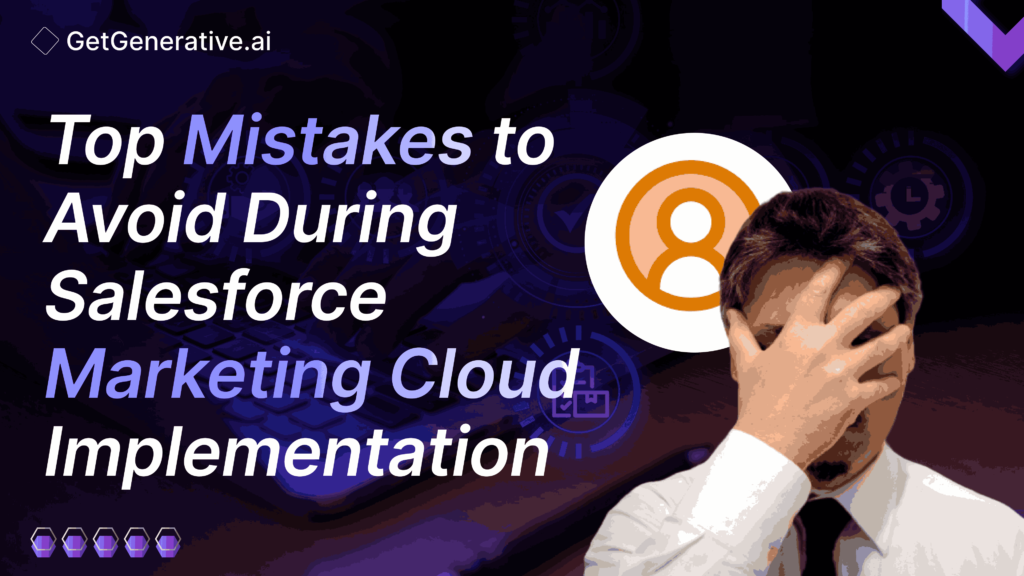Top Mistakes to Avoid During Salesforce Marketing Cloud Implementation
A successful implementation of Salesforce Marketing Cloud isn’t just about activating features; it requires careful planning, strategic alignment, and ongoing management to avoid costly mistakes.
In this article, we’ll explore the top mistakes companies make during SFMC implementation and how to sidestep them to unlock the full potential of this powerful platform.
Related Read – Salesforce Marketing Cloud Implementation Guide
Marketing Cloud Mistakes (and How to Avoid Them)
1. Skipping the Discovery Phase
Pitfall: Jumping into SFMC setup without a clear understanding of business needs, goals, and potential obstacles can lead to fragmented implementation and missed opportunities.
Solution: Conduct thorough discovery workshops with stakeholders from every department that will use or influence SFMC. These sessions should aim to understand each team’s objectives, challenges, and current processes. Taking the time to align SFMC’s capabilities with business needs will help create a seamless experience that’s geared toward achieving long-term marketing goals.
2. Not Defining Clear Objectives
Pitfall: Implementing SFMC without a roadmap of well-defined goals can lead to confusion, misalignment, and underwhelming results.
Solution: Set specific, measurable, and achievable goals that align with the broader business strategy. Ask questions such as, “Are we aiming to boost customer retention, increase engagement, or expand acquisition?” Setting up clear objectives provides a blueprint for SFMC’s implementation and helps evaluate its performance over time.
3. Overcomplicating the System with Too Many Customizations
Pitfall: The temptation to add multiple custom fields, workflows, and automation rules can make SFMC overly complex, overwhelming users and slowing down operations.
Solution: Focus on simplicity. Limit customizations to those that directly support key business processes and user workflows. An intuitive and streamlined system encourages adoption and minimizes technical issues, resulting in a more productive user experience.
4. Poor Data Quality and Lack of Data Preparation
Pitfall: Moving unclean, unstandardized, or duplicate data into SFMC can lead to inaccurate insights, impaired segmentation, and reduced efficiency.
Solution: Before migrating data, perform a comprehensive data cleanse to remove duplicates, standardize fields, and ensure data compatibility with SFMC’s structure. Proper data quality checks and deduplication practices lay a solid foundation for effective customer engagement and reliable reporting.
5. Not Training Users Adequately
Pitfall: Lack of user training is one of the most common reasons for underutilization or misuse of SFMC features, leading to poor adoption and low ROI.
Solution: Invest in customized training sessions for all SFMC users, tailored to their roles and responsibilities. Regular training boosts confidence, encourages effective use of features, and ensures users understand best practices. Follow up with periodic refreshers and updates to keep teams aligned with platform advancements.
6. Ignoring Integration with Other Systems
Pitfall: SFMC works best when it’s integrated with your existing systems, such as CRM, e-commerce platforms, and other databases. Failure to plan integrations from the start can result in data silos and inefficiencies.
Solution: Discuss integration requirements early in the process to ensure SFMC smoothly connects with your other platforms. System integration facilitates a 360-degree customer view, ensuring data consistency and supporting seamless customer experiences across channels.
7. Underestimating the Importance of Compliance
Pitfall: Ignoring data privacy laws like GDPR or CAN-SPAM can lead to legal consequences, diminished customer trust, and hefty fines.
Solution: Make compliance a priority by ensuring your SFMC setup aligns with all applicable regulations. Regularly review and update privacy practices, and utilize SFMC’s built-in compliance features to maintain the integrity and security of customer data.
8. Failure to Leverage Automation Capabilities
Pitfall: Not using automation features to their full potential can limit SFMC’s effectiveness, as automation is crucial for scaling personalized marketing efforts.
Solution: Identify repetitive tasks and communication workflows that can be automated. Use SFMC’s automation features to manage lead nurturing, segmentation, and triggered campaigns. Effective automation not only saves time but also delivers consistent and relevant customer experiences.
9. Rushing Through Testing Phases
Pitfall: Launching campaigns or new functionalities without thorough testing can lead to unexpected errors, frustrating user experiences, and potential data loss.
Solution: Set aside time to rigorously test each feature and campaign in SFMC before going live. Comprehensive testing allows you to catch and fix issues early, ensuring a smooth launch and better performance of your campaigns.
10. Failing to Document Business Requirements
Pitfall: Neglecting to document requirements can cause misalignment between business needs and SFMC capabilities, making it challenging to assess progress and maintain the system over time.
Solution: Document all requirements in detail during the discovery phase and share them with all relevant teams. This documentation serves as a reference for ongoing improvements and future adjustments, providing clarity and continuity as the business grows.
11. Using Email Address as Subscriber Key
Pitfall: Many companies use an email address as a Subscriber Key, which is problematic as it limits flexibility and can lead to inaccuracies, especially when customers change their email addresses.
Solution: Create a unique identifier for each subscriber that’s independent of their email address. This approach allows you to manage multi-channel customer data effectively and avoid complications when customers update their contact information.
12. Not Aligning Marketing and Sales Teams
Pitfall: Misalignment between sales and marketing teams can lead to inefficient workflows, missed opportunities, and a disjointed customer experience.
Solution: Use SFMC to facilitate collaboration between sales and marketing, aligning their goals and data-sharing practices. Integrated workflows and clear communication channels allow both teams to work in sync, optimizing lead nurturing and conversion rates.
13. Overlooking the Impact of Roles and Permissions
Pitfall: Mismanaging user roles and permissions can cause access issues, limiting the ability of team members to perform necessary tasks.
Solution: Define roles and permissions based on the minimum access required for each user’s responsibilities. This approach follows the Principle of Least Privilege, ensuring users have only the permissions they need to perform their tasks, thus improving security and reducing confusion.
14. Ignoring Email Deliverability Best Practices
Pitfall: Not implementing best practices for email deliverability, like proper domain verification, can lead to low engagement rates and high bounce rates.
Solution: Verify all domains used in SFMC and ensure proper Sender Authentication Package (SAP) settings, including SPF, DKIM, and DMARC records. Following deliverability best practices helps build sender reputation and improves the chances that emails reach your audience’s inbox.
15. Neglecting Post-Implementation Support
Pitfall: Launching SFMC without a plan for post-implementation support can lead to reduced user engagement, technical issues, and a lower return on investment.
Solution: Partner with a dedicated support team or consultant to monitor SFMC’s performance, resolve technical issues promptly, and ensure users have access to help when needed. Ongoing support keeps your system up-to-date and allows you to adapt to new opportunities as they arise.
Also, Read – Salesforce CRM Implementation With AI – The Ultimate Guide
Conclusion
Salesforce Marketing Cloud is a transformative tool for businesses, offering powerful capabilities for engaging with customers on a highly personalized level. However, to truly harness its potential, avoiding these common mistakes during implementation is key.
By setting clear objectives, preparing data carefully, ensuring compliance, and maintaining post-implementation support, you can pave the way for a successful and rewarding SFMC journey.
To learn more, visit GetGenerative.ai today!
FAQs
1. What is the importance of the discovery phase in SFMC implementation?
The discovery phase helps align SFMC capabilities with business goals, avoiding missteps and setting a solid foundation for implementation.
2. Why shouldn’t email addresses be used as Subscriber Keys?
Using email addresses as Subscriber Keys can lead to issues when customers update their emails. Unique identifiers are more flexible and reliable.
3. How does training impact SFMC success?
Proper training equips users to utilize SFMC features effectively, ensuring high adoption rates and a better return on investment.
4. What role does data quality play in SFMC?
Good data quality enables precise segmentation, accurate insights, and effective customer engagement, which are crucial for successful campaigns.
5. Is ongoing support necessary after implementing SFMC?
Yes, ongoing support ensures the system stays up-to-date, technical issues are promptly resolved, and users have continued access to help, maximizing SFMC’s effectiveness.




